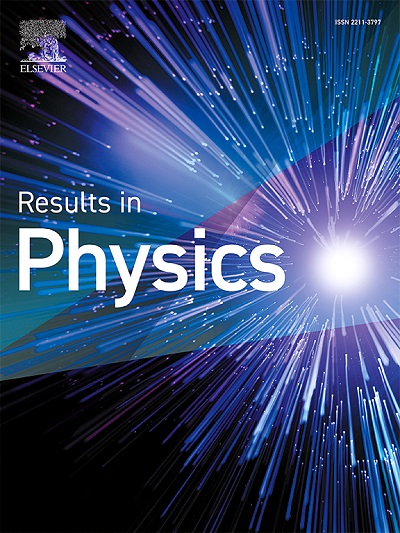MHD flow and heat transfer of Carreau nanofluid with slip effects, and modified Fourier–Fick’s law heat–mass fluxes over a paraboloid surface in porous medium
IF 4.4
2区 物理与天体物理
Q2 MATERIALS SCIENCE, MULTIDISCIPLINARY
引用次数: 0
Abstract
This study thoroughly analyzes the steady, three-dimensional boundary layer flow, heat transfer, and mass transfer of MHD Carreau nanofluid over a paraboloid surface embedded in a porous medium. It considers the integrated effects of Coriolis force, velocity slip, thermal radiation, Hall and ion slip, viscous dissipation, non-uniform heat source/sink, and chemical reactions on the flow. Main features of the analysis are the formulation of the Navier stokes equations, energy and concentration equations using the Cattaneo–Christov heat and mass flux models, rather than the classical Fourier’s law and Fick’s law, which is used to account for time relaxation effects. The governing nonlinear, coupled partial differential equations are converted into an ordinary differential system using similarity variables and then solved numerically using the finite element method. Sensitivity analysis using the response surface methodology exhibits the conditions for optimized heat transfer. The noteworthy findings are presented through graphical analyses of fluid flow parameters. The study reveals that the magnetic field slows fluid flow, while velocity increases with Hall and ion slip effects, mixed convection, concentration buoyancy parameters, and the Darcy number. Moreover, temperature increases with Brownian diffusion, the Eckert number, and radiation but decreases with a higher Prandtl number and thermal relaxation time. Moreover, as the Hall and ion slip parameters increase, the velocity profile also intensifies. The analysis reveals that the Prandtl number (Pr) is the dominant parameter, consistently exhibiting the highest Partial rank correlation coefficient(PRCC) value of 0.8650, emphasizing its crucial role in influencing the system’s behavior. Reliability is ensured through grid convergence analysis, and the numerical results were rigorously validated through detailed comparisons with previous studies and benchmark solutions. These findings are particularly relevant for energy systems, materials processing, and other industrial processes involving nanofluids in porous media, where precise control of thermal and fluid flow properties is crucial. Additionally, extending the study to other non-Newtonian fluids will broaden the applicability to a wider range of industrial applications.
考虑滑移效应的carcarau纳米流体的MHD流动和传热,以及多孔介质抛物面上的修正傅里叶-菲克定律
本研究深入分析了MHD Carreau纳米流体在嵌入多孔介质的抛物面表面上的稳定三维边界层流动、传热和传质。它考虑了科里奥利力、速度滑移、热辐射、霍尔和离子滑移、粘性耗散、非均匀热源/汇和化学反应对流动的综合影响。该分析的主要特点是使用Cattaneo-Christov热量和质量通量模型来表述Navier stokes方程、能量和浓度方程,而不是使用经典的傅立叶定律和菲克定律来解释时间松弛效应。利用相似变量将控制非线性耦合偏微分方程转化为常微分方程组,然后用有限元法进行数值求解。利用响应面法进行灵敏度分析,得到了优化传热的条件。通过对流体流动参数的图形分析,提出了值得注意的发现。研究表明,磁场减缓了流体的流动,而速度随着霍尔效应和离子滑移效应、混合对流、浓度浮力参数和达西数的增加而增加。温度随布朗扩散、Eckert数和辐射的增加而升高,随普朗特数和热松弛时间的增加而降低。此外,随着霍尔参数和离子滑移参数的增大,速度分布也随之增强。分析表明,Prandtl数(Pr)是主导参数,其偏秩相关系数(PRCC)始终最高,为0.8650,强调了其在影响系统行为中的关键作用。通过网格收敛分析确保了可靠性,并通过与前人研究和基准解的详细对比,对数值结果进行了严格验证。这些发现与能源系统、材料加工和其他涉及多孔介质中纳米流体的工业过程特别相关,在这些过程中,精确控制热和流体流动特性至关重要。此外,将研究扩展到其他非牛顿流体将扩大其在更广泛的工业应用中的适用性。
本文章由计算机程序翻译,如有差异,请以英文原文为准。
求助全文
约1分钟内获得全文
求助全文
来源期刊

Results in Physics
MATERIALS SCIENCE, MULTIDISCIPLINARYPHYSIC-PHYSICS, MULTIDISCIPLINARY
CiteScore
8.70
自引率
9.40%
发文量
754
审稿时长
50 days
期刊介绍:
Results in Physics is an open access journal offering authors the opportunity to publish in all fundamental and interdisciplinary areas of physics, materials science, and applied physics. Papers of a theoretical, computational, and experimental nature are all welcome. Results in Physics accepts papers that are scientifically sound, technically correct and provide valuable new knowledge to the physics community. Topics such as three-dimensional flow and magnetohydrodynamics are not within the scope of Results in Physics.
Results in Physics welcomes three types of papers:
1. Full research papers
2. Microarticles: very short papers, no longer than two pages. They may consist of a single, but well-described piece of information, such as:
- Data and/or a plot plus a description
- Description of a new method or instrumentation
- Negative results
- Concept or design study
3. Letters to the Editor: Letters discussing a recent article published in Results in Physics are welcome. These are objective, constructive, or educational critiques of papers published in Results in Physics. Accepted letters will be sent to the author of the original paper for a response. Each letter and response is published together. Letters should be received within 8 weeks of the article''s publication. They should not exceed 750 words of text and 10 references.
 求助内容:
求助内容: 应助结果提醒方式:
应助结果提醒方式:


